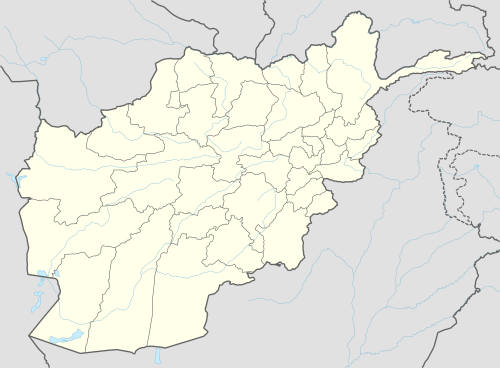Malestan District
Malistan (Dari: مالستان) is a district in the west of Ghazni Province, Afghanistan. Its population, which is 100% Hazara, was estimated at 350,000 in 2009.[1] The district capital is Mir Adina.
Malistan مالستان | |
|---|---|
 Malistan Location within Afghanistan | |
| Coordinates: 33°18′04″N 67°10′13″E | |
| Country | |
| Province | Ghazni Province |
| Capital | Mir Adina |
| Population (2009) | |
| • Total | 350,000 |
History
During the period of Dost Mohammad Khan in the 1830s the area operated as part of the semi-autonomous area of Hazarajat. In 1949 the area was separated from Jaghori District. During the Soviet Occupation Maoist resistance groups were particularly active. After Harakat lost in Qarabagh of Ghazni in 1985 to Nasr, the organizations united to force out Hizb-e Islami from the districts of Jaghori and Malistan. However, there were only sporadic clashes here and the central government lacked interest in Malistan. Around 1997, as the Taliban began to take control of Hazarajat the area was put under food blockade, leaving approximately 1 million Hazaras on the bring of starvation, including those in Malistan.
In 2002, plans were drawn up to split Malistan into four separate districts, in order to ease access to the judation, government office, huge population and distance area from Miradina, these plans are not believed to have been carried through.[2] From 2002-2008 approximately 3,801 refugees repatriated through the UNHCR system, although only 35 were listed as returning in 2008 and the fact majority occurring in 2002-04.
Security
Reported intimidation has taken place by some armed groups associated with Hizb-i Wahdat which has led to some internal displacement. Members from the Nasr faction were particularly highlighted in this, and they have been accused of abductions, extortion and other crimes.[3] Taliban presence in Ghazni has become a significant problem as well with some sources referring to the area as Taliban controlled.[4] Aside from this the major sources of conflict are related to land and water, while debt- and marriage-related conflict does occur.[5] Land conflicts increased greatly during the period of drought.
Most importantly, even though the Taliban are said, as of 2008, to have only limited activity in the district, the security situation in other parts of the province has greatly affected the livelihood of the inhabitants, posing serious threats to their life, security and freedom. The districts are inaccessible except through Taliban territory, where the road has reportedly been mined and in some areas vehicles have been banned.[6] According to some reports the road from Qarabagh District to Jaghouri, passing through Malistan is under particular threat, with kidnappings and up to 150 cars having been stolen.[7] There are also concerns that the Taliban will use the Kuchi nomads to exert their influence in the region.
Agriculture and development
According to information from the United Nations Food Program for Afghanistan in 2003 and the Ministry for Rural Rehabilitation and Development in 2007, the main crops in the area are wheat, corn, maize, peas, grapes, almonds, potatoes, onions and herbs.
182 Community Development Committees were reportedly active in Malistan in 2008.
In years following the fall of the Taliban the area has been particularly affected by drought. In combination with frequent attacks along the Kabul-Kandahar Ring Road, this has seriously affected aid and development in the system and exacerbated local conflicts.[8]
Politics
Past and present major political parties include Muttahed-e Inqelab-e Islami Afghanistan (formed 1981), Hizbullah, Harakat-i Islami, Sazman-e Nasr-e Afghanistan, Pasdaran-e Jihad-e Islami Afghanistan (formed 1983) and Hezb-e Wahdat (Nasr faction), the later controlling the district since 2001-2008, although as of 2009 the Taliban have begun to exert their influence.
The District Governor is Zafar Sharif who has no known affiliation or links to criminal groups. The Police Chief Aqhyee Abassi is affiliated with Nahzat-i Islami.from 2008-2010.
the current governor is Mr. Hedayat from Malistan and Mr. Qomandam Askaryar also from Lalchak Malistan.
Education
After the fall of the Taliban regime in Afghanistan, investment in education became one of the priorities. The willingness of its inhabitants for education is said to be proverbial: "Hazara people cut out of their basic needs in order to send their children to school and be educated" {source}.
External links
- Map of Settlements AIMS, May 2002
See also
References
- Bergh, Gina and Christian Dennyes and Idrees Zaman. "Conflict analysis: Jaghori and Malistan districts, Ghazni Privince." Cooperation for Peace and Unity. April 2009.
- "District Profile" (PDF). UNHCR. Archived from the original (PDF) on 4 March 2016. Retrieved 29 October 2015.
- Bergh, 12
- New York Times. "Two Talibans." 23 October 2009. Accessed at: https://www.nytimes.com/imagepages/2009/10/23/world/23tbmap.html [Accessed on 6 November 2009]
- Berg, 13
- Reuter Christoph, Borhan Younus. “The Return of the Taliban in Andar District: Ghazni.” Decoding the New Taliban: Insights from the Afghan Field. Ed. Antonio Giustozzi. HURST Publications Ltd. 2009.
- "Kabul Center". Kabul Center. Retrieved 2016-01-31.
- Bergh, Gina and Christian Dennyes and Idrees Zaman. "Conflict analysis: Jaghori and Malistan districts, Ghazni Province." Cooperation for Peace and Unity. April 2009.